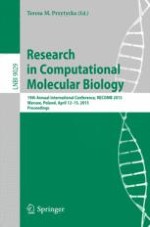2015 | Book
Research in Computational Molecular Biology
19th Annual International Conference, RECOMB 2015, Warsaw, Poland, April 12-15, 2015, Proceedings
Editor: Teresa M. Przytycka
Publisher: Springer International Publishing
Book Series : Lecture Notes in Computer Science
